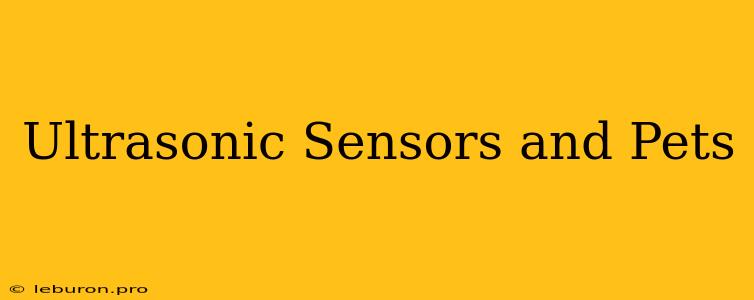Ultrasonic sensors are a common sight in modern technology, found in everything from cars to smartphones. They are versatile devices that can be used for a variety of purposes, including distance measurement, object detection, and even controlling appliances. But did you know that ultrasonic sensors can also be used for pet care? In this article, we'll delve into the world of ultrasonic sensors and pets, exploring how they can be used to improve the lives of our furry friends.
The Power of Ultrasound
Ultrasonic sensors work by emitting high-frequency sound waves, which are inaudible to humans but readily detectable by many animals, including pets. These sound waves travel outward from the sensor and bounce back when they encounter an object. The time it takes for the sound waves to return to the sensor is then used to calculate the distance between the sensor and the object. This technology has found numerous applications in various fields, from automated parking systems to robotic navigation.
Applications of Ultrasonic Sensors in Pet Care
Ultrasonic sensors have emerged as a valuable tool for pet care, offering a range of benefits for both pets and their owners. Here are some key applications:
- Pet Doors: Automated pet doors equipped with ultrasonic sensors are a godsend for pet owners who want their furry companions to have the freedom to come and go as they please. These doors use ultrasonic sensors to distinguish between pets and other objects, ensuring that only authorized animals can pass through. This helps prevent unwanted intruders from entering the house, while also providing pets with a sense of independence and security.
- Pet Activity Monitors: Ultrasonic sensors can be integrated into pet activity monitors to track the movement and activity levels of pets. This information can be helpful for identifying potential health problems, such as weight gain or decreased mobility, and for ensuring that pets are getting enough exercise. Ultrasonic sensors can even be used to monitor pet sleep patterns, providing insights into their overall well-being.
- Pet Training Aids: Ultrasonic sensors can be incorporated into pet training devices to discourage unwanted behaviors, such as barking or jumping on furniture. These devices use ultrasonic sounds that are unpleasant to pets, but not harmful, to deter them from engaging in these behaviors. The ultrasonic sensors ensure that the devices only activate when the target behavior is detected, minimizing the risk of false alarms.
- Automatic Pet Feeders: Ultrasonic sensors can be used in automatic pet feeders to monitor the amount of food remaining in the bowl. This allows pet owners to ensure that their pets are always adequately fed, even when they are away from home. Some feeders also use ultrasonic sensors to detect the presence of pets and dispense food only when they are nearby, preventing food waste and ensuring that the food is always fresh.
- Pet Safety Devices: Ultrasonic sensors can be used to develop pet safety devices that alert owners to potential dangers. For example, some devices use ultrasonic sensors to detect the presence of pets in enclosed spaces, such as cars, and alert owners if a pet is left unattended. Others use ultrasonic sensors to create virtual fences that keep pets confined to specific areas, providing a safe and secure environment for them to play and explore.
Advantages of Ultrasonic Sensors in Pet Care
Ultrasonic sensors offer numerous advantages for pet care, making them an attractive solution for pet owners seeking to improve the lives of their beloved companions. Here are some of the key benefits:
- Non-invasive: Ultrasonic sensors are non-invasive, meaning that they do not require physical contact with pets. This makes them a safe and comfortable option for animals, especially those who may be sensitive to touch or have medical conditions that make them vulnerable to invasive procedures.
- Accurate and Reliable: Ultrasonic sensors provide accurate and reliable data about the distance between the sensor and an object. This makes them ideal for applications where precise measurement is required, such as pet doors and activity monitors.
- Versatile: Ultrasonic sensors can be adapted to a wide range of applications, from monitoring pet behavior to detecting potential hazards. Their versatility makes them a valuable tool for improving pet care in a variety of ways.
- Cost-Effective: Ultrasonic sensors are relatively inexpensive, making them accessible to pet owners with different budgets. Their affordability makes them a practical solution for improving the lives of pets without breaking the bank.
Conclusion
Ultrasonic sensors are revolutionizing the way we care for our pets, offering innovative solutions that address a range of needs. From providing pets with greater independence to monitoring their health and safety, these sensors are making a real difference in the lives of our furry friends. As the technology continues to evolve, we can expect to see even more exciting applications of ultrasonic sensors in the field of pet care, further improving the well-being of our beloved companions.
